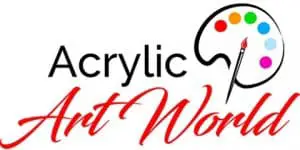Acrylic and watercolor paints are both popular mediums for artists. There are a few similarities between the two paints, but they remain very distinct from one another. I will explain why that is in this article, as well as some advantages and disadvantages to each.
Watercolor painting has been practiced throughout history and because watercolors are such a simple medium, they have remained relatively unchanged over time — think ancient Chinese scroll paintings. Both paints are water-based, but watercolors can be rewetted while acrylic is not water soluble once it has dried.
Watercolor paint is made up of a pigment (natural or synthetic) and a binder (often this is gum-arabic), and–depending on the type you use–extra additives for performance and a bit of water. Soft watercolors that come in tubes and can be squeezed out are pre-mixed with water, whereas the most popular kind comes as a pallet of dry cakes with a very low water content. You mix in the water by wetting your brush.
Though acrylics are also water-based and can be diluted and used similarly to watercolors, there are key differences. Acrylics lose their water-solubility once dry, as mentioned above, and therefore you can’t overlap colors like you can with watercolors. Acrylic paints come in so many varieties, some of which are customized to more closely mimic watercolors. Even so, achieving the signature fluidity and layering of the latter is nearly impossible.
The Pros and Cons of Working With Acrylic Paints
Acrylic paints were developed in the 20th century after the German chemical company BASF created acrylic resin in the 30’s. By the 40’s, innovations in these synthetic paints led to their use not only for commercial and industrial applications but also for fine arts. The water-based version of acrylic paint that we know so well today, came into popular use in the late 1950’s.
We know acrylic paint to be convenient, affordable, and versatile; so versatile, in fact, that it can often replace other mediums. Acrylic paint technology is not perfect, however. Watercolors have unique qualities, so it’s important to know what you may be giving up when you opt for acrylics instead. Here are some advantages and disadvantages of acrylics.
Pros:
- Vibrancy. Even watered down, acrylic paint colors remain vibrant. Most importantly, when you put the wet color down you can expect it to dry the same color. This isn’t always true for watercolors.
- Mixing. For the beginner, mixing acrylic paint colors can be easier than mixing watercolor paints–namely the ones that come in dry cakes. You simply have to mix the already fluid paints to an even consistency, then dilute them with water. Only small swathes of watercolors can be mixed at a time because you have to activate them with a wet brush.
- Durability of the artwork. Painting with acrylics makes for less chance the final painting will succumb to damage. This inherent durability is because the acrylic paint becomes non-water-soluble after it dries. It can not be re-wetted. That being said, there are always fixatives available for protecting watercolors, and no matter the medium it’s usually a good practice to glaze your art in some way.
Cons:
- Dries non-water-soluble. Above I mentioned how this can be a benefit of acrylic paints, making the artwork less damage prone; however, a paint that you can re-wett, like watercolors, or that dries slowly like oils, is superior if you like to re-work your paintings over time.
- Opacity. Again, it always depends on what you’re looking for, but acrylics will not achieve the same transparency that watercolors do. If you’re going for that fluid look that you see with Chinese ink paintings or watercolors–acrylics aren’t your best option.
- Drying time. The quick dry time for acrylics is often considered a benefit, but it makes for a poor watercolor substitute. Once the paint is dry there is no going back to increase translucence like you can with watercolors.
The Pros and Cons of Working With Watercolor
Watercolor paintings are unique and ethereal. They have been frequently used as a “sketching” medium, to draft out ideas, but they are also beautiful paintings in their own right. Winslow Homer is a well-loved American painter who often worked in oils, but many art critics consider his watercolors to be his best work. There are occasions you might want to work in this medium and occasions you might prefer something bolder. I will lay out some of the pros and cons of working in watercolors to help you decide.
Pros:
- Tradition. Like oil painters, watercolor artists know their medium well. There is something to be said for learning the tricks of the trade, and taking full creative advantage of the unique characteristics of a medium like watercolor.
- Simplicity. Watercolors vary in terms of what’s in the paint mixture, but in general they are a very basic formula consisting of pigment and some sort of gum as binding agent. You supply the water. Simplicity also means easy to clean and safe. Their water-solubility makes for a swift cleanup. Finally, it’s never a good idea to eat paint, but you can be sure they’re non-toxic when using them as intended!
- Water-solubility. Not only does this quality make them less messy, but it provides a unique opportunity for reworking your image even after it has dried. All you have to do is re-wet the paint.
Cons:
- Paper. Any painting medium as wet as watercolor will require the use of a thicker, more durable paper. Watercolors themselves are affordable but the paper is an added expense.
- Practice and technique. Getting the hang of applying brush strokes sparingly so you don’t soak and tear the paper can be one of the biggest frustrations with this medium. As I mentioned above there are designated papers for use with watercolors, but even so it takes practice. It’s not uncommon for colors to end up muddy or the paper to pucker and bulge in areas. Don’t give up; you’ll develop a technique over time.
When to Use Watercolor vs. Acrylics
Watercolors and acrylics are distinct mediums, but they can also be used in ways that make them resemble one another. For example, there are thicker watercolors that come in pastes, and there are thinner acrylics more readily diluted. Here are some scenarios in which I’d use one or the other, in case anecdotes are more helpful.
I love to make watercolors for my friends and family. They make great gifts. They’re quick and can be spontaneous, so it feels good to give them away.
Though there are plenty of watercolor artists who create masterpieces in this medium, I love to use these paints for quick visual studies. If you treat watercolor paintings sort of like you would treat composing a haiku, I think you’d quickly learn a lot about the basic elements of painting.
Acrylic paints are known for being more versatile in terms of what they can bind to. If you’re experimenting with materials and want to paint on fabrics, or even leather, acrylic paint would be the perfect medium.

